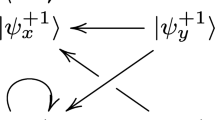Abstract
Quantum logic is only applicable to microscopic phenomena while classical logic is exclusively used for everyday reasoning, including mathematics. It is shown that both logics are unified in the framework of modal interpretation. This proposed method deals with classical propositions as latently modalized propositions in the sense that they exhibit manifest modalities to form quantum logic only when interacting with other classical subsystems.
Similar content being viewed by others
Notes
A Hilbert space is a vector space with an inner product that is complete with respect to the metric induced by this inner product. In quantum theory, a state space of a physical system under consideration is given by a Hilbert space.
An ortholattice is a lattice along with what is called the orthocomplementation operation. A Boolean algebra is a special case of an ortholattice.
A projection operator P on a Hilbert space \({\mathbb{H}}\) is a linear operator with the property that P 2 = P. A closed subspace of \({\mathbb{H}}\) can be identified with a projection operator on \({\mathbb{H}}\) whose range is that subspace.
An inner product in \({\mathbb{H}}\) is a bilinear operation that assigns to each pair of vectors i, j in \({\mathbb{H}}\) a scalar value denoted by \(\langle i|j \rangle.\) The geometric notions of orthogonality and length are both defined in terms of this inner product.
A reflexive and symmetric relation R on \({\mathbb{H}}\) is a binary relation such that the following properties hold: (1) Reflexivity: R(i, i) for all \({i \in {\mathbb{H}},}\) (2) Symmetry: If R(i, j) then R(j, i) for all \({i, j \in {\mathbb{H}}.}\)
The τ-image of all formulas is isomorphic to some ortholattice. Intuitively, τ-image τ(f) of a formula f is considered to represent a closed subspace of some Hilbert space.
An equivalence relation on I λ is a binary relation such that the following properties hold: (1) Reflexivity: S λ(i, i) for all \(i \in I_{\lambda},\) (2) Symmetry: If S λ(i, j) then S λ(j, i) for all \(i, j \in I_{\lambda},\) (3) Transitivity: If S λ(i, j) and S λ(j, k) then S λ(i, k) for all \(i, j, k \in I_{\lambda}.\)
\({{\mathbb{R}}^3}\) is one of the most typical examples of a Hilbert space.
Here {u} ∪ {v} is the smallest element of \({{\fancyscript{P}}}\) that contains both {u} and {v} as subsets.
References
Dalla Chiara M, Giuntini R, Greechie R (2004) Reasoning in quantum theory. Kluwer, Dordrecht
Dishkant H (1977) Embedding of the quantum logic in the modal system of brower. J Symb Logic 42(3):321–328
Hardegree GM (1976) The conditional in quantum logic. In: Logic and probability in quantum mechanics. Reidel, Dordrecht, pp 55–72
Hughes GE, Cresswell MJ (1996) A new introduction to modal logic. Routledge, London
Hughes RIG (1989) The structure and interpretation of quantum mechanics. Harvard University Press, Cambridge
Kochen S, Specker EP (1965) Logical structures arising in quantum theory. In: 1965 theory of models (Proceedings of 1963 international symposium at Berkeley). North-Holland, Amsterdam, pp 177–189
Strauss M (1972) The logic of complementarity and the foundation of quantum theory. In: Modern physics and its philosophy. Reidel, Dordrecht, pp 186–199
Author information
Authors and Affiliations
Corresponding author
Rights and permissions
About this article
Cite this article
Tokuo, K. Unified Interpretation of Quantum and Classical Logics. Axiomathes 24, 1–7 (2014). https://doi.org/10.1007/s10516-012-9199-7
Received:
Accepted:
Published:
Issue Date:
DOI: https://doi.org/10.1007/s10516-012-9199-7



